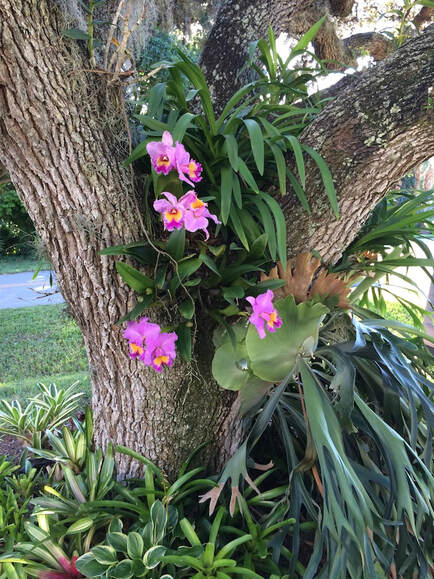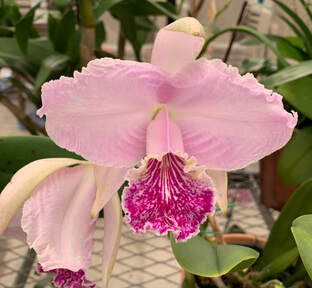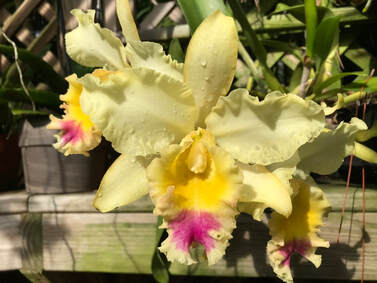|
Better-GroOrchidBlog
 C. Spring Drumb 'Volcano Queen' C. Spring Drumb 'Volcano Queen' Cattleyas are an easy-to-grow orchid (which is one reason why they’re used in many orchid hybrids). If you’ve never grown a Cattleya before, however, there are some things to know about them. Namely, they love indirect light and don’t need frequent waterings. Here’s more information on growing these orchids. When discussing Cattleya care, it’s appropriate to begin with lighting and watering. The two most common mistakes people make with Cattleyas are giving the flowers too little light and too much water. After reviewing the proper lighting conditions and watering regime for Cattleyas, we’ll go into feeding, monitoring the temperature and repotting. Cattleyas Love Indirect Light Cattleyas love indirect light, and lots of it. In fact, they won’t flower if they don’t receive enough light. While Cattleyas need lots of light, they won’t fare well in direct sunlight. In the wild, they grow on the side of trees in Central and South America. They sit above much of the ground-level vegetation, so they get a decent amount of sunlight, but they’re below the forest’s canopy, so the light is filtered by trees’ leaves. Thus, they’re acclimated to and need indirect light. When selecting a location for your Cattleya, keep this lighting requirement in mind. Some good options are:
 C. lueddemanniana “Arthur Chadwick” C. lueddemanniana “Arthur Chadwick” Cattleyas Need Water About Once a Week The amount of water your Cattleya needs will depend on where it is in its growth cycle. When spikes are growing, it’ll need more water than when it’s resting or flowering. How often to water Cattleya depends on how it is potted and the type of potting mix used. For example, some potting medias (like a very coarse mix) and containers (like cedar baskets) allow the plant to dry out quickly, so you may have to water 2 or 3 times per week. However, if you use a potting media that holds moisture longer (like sphagnum moss), you may only water every 7 to 10 days. Keep in mind that even if you’re on a watering schedule, the humidity and weather can change everything. When watering, thoroughly soak the growing medium. Then, let it almost completely dry out before the next watering. After all, these flowers are used to growing on trees that don’t retain water. They aren’t accustomed to being in continually wet soil. If you’re in doubt as to whether your Cattleya needs water, wait one more day before watering it. While you should soak the growing medium, no part of the Cattleya should sit in still water. If the roots sit in water, they’ll rot. Similarly, if you water the plant too much when it’s flowering, water in the spike may rot young buds.  Blc. Yuko Ito 'Volcano Queen' Blc. Yuko Ito 'Volcano Queen' Cattleyas Do Best with an Orchid Specific Fertilizer If you don’t have an orchid-specific fertilizer, you can feed Cattleyas (as well as many other orchids) weakly weekly. That is, give them a standard 10-10-10 fertilizer at half strength or a 20-20-20- fertilizer at quarter strength once a week. When your orchid rests after the growing season, the feeding should be reduced to once every two weeks until the next growing season. For best results, however, Cattleyas should be fed with a fertilizer that’s specifically developed for orchids. We recommend alternating feedings between our Orchid Plus Plant Food and our Orchid Better-Bloom Plant Food, which are scientifically crafted to promote healthy growth and large, bright flowers. Feedings should be once a week when you’re orchid’s growing and flowering, and every other week when it’s resting. Cattleyas Like Hot Days and Cool Nights Cattleyas, especially large ones, enjoy big temperature swings. While smaller species don’t need quite as drastic changes in temperature, larger varieties of Cattleyas won’t flower without significant differences between day and night temperatures. Standard-sized Cattleyas prefer the temperature to be in the 80s or lower 90s during the day, and to have it dip down into the 50s at night. Miniature varieties, which tend to be under 12 inches, fare better with daytime temperatures between 65 and 75 degrees. When keeping Cattleyas indoors, it can be difficult to create significant temperature swings. If you aren’t able to manipulate temperatures so that your Cattleya at least sees temperature differentials during its flowering season, you may want to consider a smaller Cattleya. You’ll still need to find a way to cool it off during the night, but you can leave most smaller species at room temperature during the day. Cattleyas Should Be Repotted Every Few Years
Every few years, Cattleyas will need to be repotted. They should be put in a new container whenever:
Happy Blooming! Comments are closed.
|
Resources
|
Company |
|
